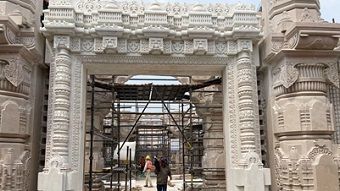A comprehensive security plan, valued at ₹39.2 crore, is set to deliver a substantial boost to the security of the upcoming Shri Ram Janmabhoomi Mandir Teerth Kshetra in Ayodhya, which is projected to be inaugurated in January 2024. The plan has been chalked out in the wake of elevated threat perceptions.
The government, in its August 11 order, authorised funds for the initial phase of security equipment installation, outlining the full spectrum of security features. These measures encompass CCTV systems for continuous surveillance, access control equipment (including drone cameras), X-ray baggage scanners, and protective gear such as bulletproof jackets, vehicles, dragon lights, binoculars, emergency alarm systems, and hooters.
In a video release dated August 4, Prashant Kumar, Special Director General of Uttar Pradesh Police for Law and Order, emphasised the implementation of advanced security measures and comprehensive crowd management systems prior to the temple’s anticipated opening next year. He underscored that the surveillance and access control strategy has been meticulously designed to anticipate a substantial surge in pilgrim footfall in Ayodhya, akin to the influx observed in Varanasi following the inauguration of the new Kashi Vishwanath corridor in 2022.
The recent order further details the supply, installation, testing, and commissioning (SITC) of surveillance/CCTV systems amounting to ₹10.97 crore, access control systems valued at ₹8.56 crore, protective equipment worth ₹3.38 crore, riverine equipment totalling ₹2.84 crore, along with various other components. The aggregate cost of these gadgets and equipment is ₹31.41 crore, inclusive of labour cess and contingency at a rate of 1%, as well as GST and government agency charges at 18% and 8%, respectively, attributed to the Uttar Pradesh Rajkiya Nirman Nigam overseeing the entire project.
The surveillance system roster encompasses five-megapixel or higher resolution bullet cameras, four-megapixel or superior resolution full high definition PTZ (Pan-Tilt-Zoom) infrared dome cameras, fixed or bullet outdoor infrared cameras for Automatic Number Plate Recognition (ANPR) system, indoor infrared cameras with a minimum five-megapixel resolution, local processing unit for ANPR, PTZ controller with LED display, and 128 GB surveillance secure digital (SD) cards.
The access control system roster also incorporates drone cameras, X-ray baggage scanners, multizone door-fitted metal detectors, and handheld metal detectors. Additional security provisions encompass dragon lights, binoculars, hand grip megaphones, and emergency alarms with sirens. Beyond the surveillance and access control apparatus, the comprehensive security plan allocates ₹7.78 crore for riverine security equipment, encompassing motorboats and life jackets. This allocation is in consideration of events like melas and snans (ritual baths) organised during various religious occasions.
In addition to the state police, specialised agencies such as the Special Task Force (STF) and the Anti-Terrorism Squad (ATS) will be engaged for this initiative. The security strategy also involves deploying the state disaster response force at the ghats to mitigate drowning incidents.








